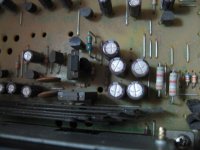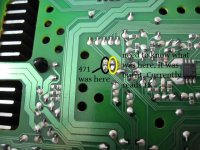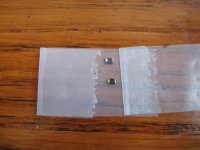My aunt gave me her Kenwood radio (VR 307)... said it "just stopped working"... 
Upon opening it I found one cap bubbled the top and burst the seam open a little. This 100v 10 microfarad cap is found in location C26.

After removing the main board I found a toasted chip resistor reading 1K ohms and one right next to it that reads 470 ohms (chip has 471 on it, should be good) but I'm not sure if the smoked one was suppose to be a 471 also or if it should be something different. There is NO printing on the bottom of the board what so ever to identify this location... so I have no way to even identify it other than in this pic.
so I have no way to even identify it other than in this pic.

These chip resistors are very small... but I've seen them a little smaller, so maybe the second smallest I've seen.
Here is a pic of them.

Any idea what rating that chip resistor should be? and where I can buy them?
When I power it up, it turns on then goes into protect mode and the display turns off.
Is there any other things I should be checking? This is the only visible damage I've found. I've tested many of the other resistors and they are all within tolerance. The other 5 caps in that area are all reading good too.
Thanks in advance for helpin a newb.
Upon opening it I found one cap bubbled the top and burst the seam open a little. This 100v 10 microfarad cap is found in location C26.

After removing the main board I found a toasted chip resistor reading 1K ohms and one right next to it that reads 470 ohms (chip has 471 on it, should be good) but I'm not sure if the smoked one was suppose to be a 471 also or if it should be something different. There is NO printing on the bottom of the board what so ever to identify this location...
 so I have no way to even identify it other than in this pic.
so I have no way to even identify it other than in this pic. 
These chip resistors are very small... but I've seen them a little smaller, so maybe the second smallest I've seen.
Here is a pic of them.

Any idea what rating that chip resistor should be? and where I can buy them?
When I power it up, it turns on then goes into protect mode and the display turns off.
Is there any other things I should be checking? This is the only visible damage I've found. I've tested many of the other resistors and they are all within tolerance. The other 5 caps in that area are all reading good too.
Thanks in advance for helpin a newb.
Fixed the damage... but it still goes into protect... 
Turns on, face lights up, mute blinks, as soon as it should click to turn on it goes into protect and the face goes dark and the standby light blinks.... hmmmm
What do you guys think?
I don't suppose someone could tell me the voltages I should be seeing from the L07-2693-05 power transformer? I wanna make sure its working properly.
Any other things I could look for would be greatly appreciated.
Thanks.

Turns on, face lights up, mute blinks, as soon as it should click to turn on it goes into protect and the face goes dark and the standby light blinks.... hmmmm
What do you guys think?
I don't suppose someone could tell me the voltages I should be seeing from the L07-2693-05 power transformer? I wanna make sure its working properly.
Any other things I could look for would be greatly appreciated.
Thanks.
So did some more testing and found a few most bad transistors.
Q32 - A1285 - found data sheet, but can't seem to find one to purchase... are there any suitable replacements?
Q36 - A1535A - Found a couple on ebay...
Q2 - B1640 - found data sheet, but can't seem to find one to purchase... are there any suitable replacements?
Q17/18 - C1845 - found data sheet, but can't seem to find one to purchase... are there any suitable replacements?
Is there a good parts supply place in america? or will I have to purchase these over seas?
I'd like to get this thing running a.s.a.p.
Q32 - A1285 - found data sheet, but can't seem to find one to purchase... are there any suitable replacements?
Q36 - A1535A - Found a couple on ebay...
Q2 - B1640 - found data sheet, but can't seem to find one to purchase... are there any suitable replacements?
Q17/18 - C1845 - found data sheet, but can't seem to find one to purchase... are there any suitable replacements?
Is there a good parts supply place in america? or will I have to purchase these over seas?
I'd like to get this thing running a.s.a.p.
The transistors you mentioned will have prefixes to the parts which may make identifying and sourcing them easier.
Q32-2SA1285
Q36-2SA1535A
Q2-2SB1640
Q17/18-2SC1845
Due to the fact these are factory parts, some may be difficult if not impossible to source as a hobbyist as some may even be out of production. Be careful with eBay as some sellers are known to sell fakes but your best places to try are all the usual big suppliers (Farnell, Digikey, Mouser). If you can't find them there, then you may have to start looking at substituting parts based on the data in datasheets.
Also, did you test the transistors whilst they were in circuit (ie. soldered in place) or did you remove them and check them. Testing them in circuit can bring up false readings. How did you check them (multimeter for example)?
Edit: I took a look on Digikey and the only part available was the 2SA1535A (Q36).
Q32-2SA1285
Q36-2SA1535A
Q2-2SB1640
Q17/18-2SC1845
Due to the fact these are factory parts, some may be difficult if not impossible to source as a hobbyist as some may even be out of production. Be careful with eBay as some sellers are known to sell fakes but your best places to try are all the usual big suppliers (Farnell, Digikey, Mouser). If you can't find them there, then you may have to start looking at substituting parts based on the data in datasheets.
Also, did you test the transistors whilst they were in circuit (ie. soldered in place) or did you remove them and check them. Testing them in circuit can bring up false readings. How did you check them (multimeter for example)?
Edit: I took a look on Digikey and the only part available was the 2SA1535A (Q36).
Last edited:
Ohh good job. Did you use a multimeter on diode or continuity check mode? Also, did you know what pins you were measuring (seeing as you couldn't find the datasheet for one or two devices)? Here is a good guide showing how to do it and what kind of results you should expect when measuring: Multimeters
Well... I'm definitely no pro... but learning quickly... lol
I used my DMM set to diode and followed the instructions I found here. About half way down the page.
They are all PNP transistors. All 5 of them show full power when attempting to close the gate. Red lead on gate, black on source. Should I be seeing .6v+ when trying to close the gate?
the other two- C1845's the drain and source are shorted together.
I used my DMM set to diode and followed the instructions I found here. About half way down the page.
They are all PNP transistors. All 5 of them show full power when attempting to close the gate. Red lead on gate, black on source. Should I be seeing .6v+ when trying to close the gate?
the other two- C1845's the drain and source are shorted together.
Last edited:
You need to use the instructions just a bit further down that page titled `Checking Bipolar Junction Transistors (BJT's)` for your devices as all of them are BJT's not FET's (which operate on different principals). It might be a better idea to stick to the guide in my link though as it is much more simple and easier to follow.
You will also need to check the datasheets as the pins may be different ways round on each device, altering where you put you multimeter leads and what kind of readings you should expect.
You will also need to check the datasheets as the pins may be different ways round on each device, altering where you put you multimeter leads and what kind of readings you should expect.
- Status
- This old topic is closed. If you want to reopen this topic, contact a moderator using the "Report Post" button.
- Home
- Amplifiers
- Chip Amps
- Kenwood VR307 Need help...